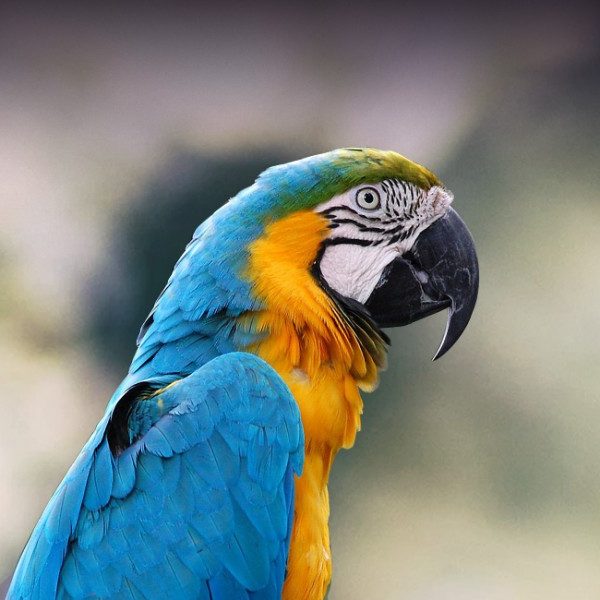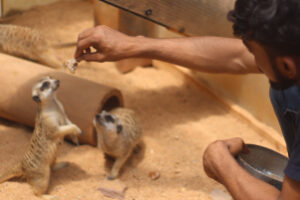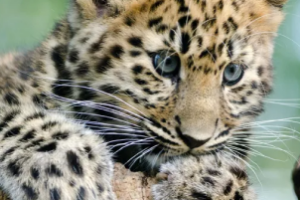
WORLD OF ANIMALS : MACAW’S
Macaw is a common name of about 18 species of large colourful parrots native to tropical North and South America. These brightly coloured long-tailed birds are some of the most spectacular parrots in the world. They are very sociable and friendly. Macaws also have gripping toes that they use to latch onto branches and to grab, hold, and examine items. The birds sport graceful tails that are typically very long. Macaws are classified in the genera Ara, Anodorhynchus, Cyanopsitta, Primolius, Orthopsittaca, and Diopsittaca in the family Psittacidae.
Macaws are informally classified into two groups: large macaws and mini macaws. The large macaws include those of the Ara, Anodorhynchus, and Cyanopsitta genera. This “blue macaws” group includes the hyacinth, along with the critically endangered Lear’s macaw and Spix’s macaw. The mini macaws are much smaller and include those from the genera Diopsittaca, Orthopsittaca, and Primolius.
Both male and female macaws look alike. Macaws are known as the giants of the parrot world. The hyacinth macaw is the longest parrot, with a head to tail length of nearly 40 inches although there are 18 living species of macaws, not all commonly get adopted by people. The commonly kept companion macaw species include the following, listed by common name and scientific name: blue-and-gold macaw (Ara ararauna), green-winged macaw (Ara chloropterus), Hahn’s macaw (Diopsittaca nobilis nobilis), hyacinth macaw (Anodorhynchus hyacinthinus), scarlet macaw (Ara macao), military macaw (Ara militaris), and severe macaw (Ara severus). Some of these species have other common names. For example, the blue-and-gold macaw is sometimes called the blue-and-yellow macaw, and the military macaw is sometimes called the chestnut-fronted macaw.
Macaws are easily tamed, and some can mimic sounds. Although these parrots often shriek noisily, gnaw, and occasionally bite with their powerful beaks, many local people keep them as pets. They mostly have a lifespan of 30+ years. A few macaws have survived to 65 years old in captivity.
Habitat
Macaws are native to Central America and North America (only Mexico), South America, and formerly the Caribbean. Most species are associated with forests, especially rainforests, but others prefer woodland or savannah-like habitats.
Care and Feeding
A Macaw requires a large cage because of its large body and in order to prevent its tail from getting hit at the bottom, which may cause the tail feathers to break or bend. Looking over all the aspects a macaw requires a comparatively larger cage than other birds.
In their natural habitat, macaws feed on native seeds, fruits, flowers, leaves, palm nuts, figs, nectar, and, in some regions, clay from exposed river banks. They eat a variety of foods including seeds, nuts, fruits, palm fruits, leaves, flowers, and stems, they also like to eat Vegetables. Safe vegetables include asparagus, beets, bell peppers, broccoli, butternut, carrots, corn on the cob, dandelion greens, collard greens, hot peppers, spinach, sweet potatoes, tomatoes and zucchini. The dietary needs of some macaw species differ from that of other parrots because they need more fat in their diet. The wild macaw’s diet tends to be high in fat, which is acceptable for a bird that spends its day flying through the rainforest, finding food, nesting, and taking care of babies.
Breeding
Sexing Macaws
All macaws are sexually monomorphic. This means the sex of macaws cannot be reliably determined by physical characteristics, though the males are usually larger with larger heads.
Their sex must be determined by either a surgical probe called endoscopy, which can be done by many veterinarians; by DNA testing, usually a blood sample or a few plucked feathers sent to be diagnosed in a lab; or a chromosomal analysis.
Pairing Macaws
Macaws breed readily but the sexes must be confirmed and the pair must be harmonious, bonded with each other.
It is best to let them select their own mates. This is best done in the winter a couple of months before breeding season.
The ideal breeding ages are 4 – 8 years, with a maximum breeding age of 30 – 35 years for the largest macaws.
Breeding Environment
Macaw breeders will need a nest box. The macaws nest box needs to be about three times the macaws body length in height and one body length in width and depth. The hole needs to be just large enough for an adult to enter.
There needs to be some blocks secured inside the box for the birds to climb out and also several blocks of wood on the inside walls for chewing. Provide 4″ – 8″ of wood shavings in the bottom of the nest box. Mount the next box high up in a corner facing outwards, a place that provides seclusion and safety.
Egg Laying and Hatchlings
Most macaw species lay clutches of 2 – 3 eggs. The larger macaws will lay an egg every other day and the smaller macaws will lay every third day. The incubation period is 26-28 days. Once the hatchlings are born the parents will need a ready supply of food, especially like corn on the cob, fresh fruits, milk soaked bread and cuttlebones. The weaning ranges from 10 weeks to 8 months, depending on the species.
Personality and Behaviour
Everything about a macaw is big, from their voices to their attitudes. This applies to the mini macaws as well — on the inside! Colourful and often raucous, they call attention to themselves even when quiet. Although to some can even mimic the human voice, macaws seem formidable and may bluster and carry on, those who share their lives with these magnificent friends know that they contain surprisingly loving hearts and sensitive natures.
Macaws are intelligent and quite playful and love toys they can chew up, especially items made of wood. A pet macaw will need a consistent supply of appropriate toys and other safe items to destroy. The cost of a stable supply of toys must be considered while planning a monthly pet budget. Macaws are intelligent birds that also thrive on activities designed to challenge them, such as foraging activities. Foraging involves searching for food or time spent enjoying food.
As said earlier macaws are very playful and might make a game out of spooking people by leaning forward and lunging toward them. This is not done as an aggressive gesture but is more for the reaction it causes. In general, a well-socialized, positively interacted with macaw can be a gentle pet.
Speech and Sound
Large macaws have equally large vocalizations, and their squawks and screeches are quite loud and ear piercing. A potential macaw owner needs to take sound into consideration, especially if he or she lives in an apartment and/or has nearby neighbours. Macaws can be taught to talk and they might also be inclined to whistle or to imitate sounds and noises they hear inside or outside the home.
General Health Concerns
Macaws are prone to feather-destructive behaviours. If a complete veterinary medical condition of feather plucking, boredom and/or lack of appropriate mental stimulation can be a cause. Offer the macaw an enriched environment with plenty of opportunities for play and exercise, such as climbing nets and ropes, in addition to toys.
Macaws are also more susceptible to proventricular dilatation disease (PDD), psittacine beak and feather disease (PBFD), psittacosis, beak malocclusion, and aspergillosis. Regular health checkups by an avian veterinarian can help diagnose and treat many disease processes early on.
It is normal for a macaw to sneeze a few times a day to clear out dust or dander from its nares, which might be accompanied by a clear discharge. But if the sneezing is persistent and/or the discharge is not a clear colour, contact your avian veterinarian and get an appointment fixed for your pet to avoid any severe conditions.
Conservation Status
The majority of macaws are now endangered in the wild and a few are extinct. The Spix’s macaw is now probably extinct in the wild. The glaucous macaw is also probably extinct, with only two reliable records of sightings in the 20th century. The greatest problems threatening the macaw population are the rapid rate of deforestation and illegal trapping for the bird trade.
Interesting Facts
- No two macaws have the same feather pattern on their face. It is somewhat like human fingerprints.
- Macaws have black or grey eyes when they are young and later change to brownish and then yellow when they get old.




